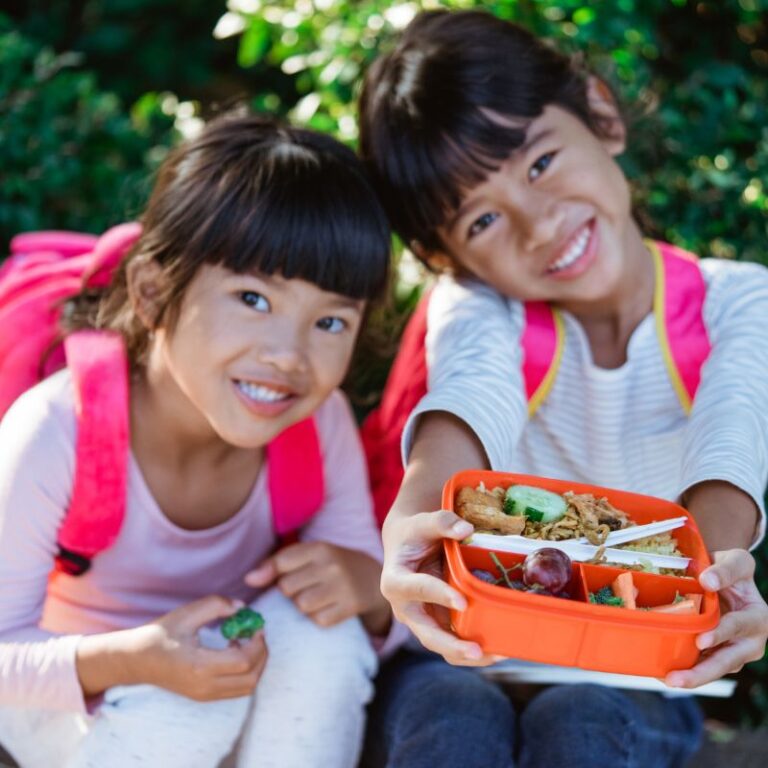
It’s that time of year again when cute princesses, scary ghosts and cackling witches show up at your doorstep for Trick or Treat on Halloween … (let’s be honest, they just want a treat!).
As a registered dietitian, I often get asked about Halloween and how to “manage the candy situation” that night, as well as dealing with it the other 364 days of the year.
Let me cut right to the chase and present my sophisticated theory:
If you decide to let your kids participate in Halloween, then you need to be okay with your kids eating the candy that they bring home. Period.
Even if you don’t go Trick or Treating, but go to a party or community event, there will likely be some sort of candy or treats there. If you are sending your children, then you need to let them partake.
Plain and simple.
But shouldn’t I be worried about candy?
In the grand scheme of things to be worried about for your child, I hope that candy isn’t the one occupying the most brain space. (If having candy in your house or watching your child eat candy brings on a lot of anxiety, please reach out.)
When given to children within the confines of a healthy feeding relationship, in a home where the division of responsibility in feeding is practiced, and where foods are not overtly praised for elitist nutritional qualities or shunned for being toxic, candy and treats shouldn’t be a big deal.
In fact, what we should be more worried about is candy restriction.
(P.S. Stay tuned for an upcoming blog on the division of responsibility in feeding but for now, check out Ellyn Satter’s website here, along with more comments in this article below.)

Why candy restriction doesn’t work.
One might believe that simply never having candy in the house or never allowing your child to eat candy would be the best approach. However, that ‘avoid-at-all-costs’ mentality around treats is not serving you or your child.
Evidence has, and continues to show, that restriction of highly desirable foods, including Halloween treats, is often counterproductive. Whenever a food (or anything else for that matter) is restricted, it tends to draw a child’s attention MORE towards the restricted food and increases his or her determination to get it, sometimes at all costs, including sneaking or stealing.
If or when the child gets access to the forbidden food, the consumption of that food is much greater than if the food had not been restricted in the first place. (This is also true of adult’s behaviour.)
We also know that some children are much more susceptible to the negative effects of restriction. This study found that preschool children with low inhibitory control (i.e. kids who find it difficult to resist or delay gratification), and high levels of motivation to search out food ate bigger amounts when a restricted food was obtained.
Research also shows that children who are restricted or deprived of highly palatable snack foods (i.e. high-sugar or high-fat foods) show high levels of eating in the absence of hunger (EAH), and tend to eat more and feel worse about their eating when they do get to consume the treat food.
Taken together, we can conclude that NOT allowing candy isn’t the best approach… but what is?
So I should give my kid candy everyday?
Whether you offer you child candy and/or treat food everyday is your parenting choice.
My recommendation is that you do not severely restrict it or make a huge fuss when it’s ice cream or chocolate night. Food is food. The more we can take the idol status off candy (and kale for that matter) and level the playing field and narrative with which we speak about food to our children, the better off we will be.
Over the years, I’ve learned that parenting is very personal and what we choose (or are forced) to feed our children is a combination of various factors including our geographical location, access to food, socioeconomic status, available time, food/nutrition philosophy, parenting style, our personal past food experiences and dieting history, a child’s medical history and so on.
Ideally, growing bodies have access to a variety of different foods and their related nutrients. Candy can be a part of this but is hopefully not the central or sole energy provider because it lacks many key nutrients including vitamins, minerals, fibre, protein, and healthy fats.
I believe it can be part of a nourishing pattern of eating without crowding out other nutrient-rich foods.
5 Tips for How to Handle the Halloween Haul
For those who are headed out Trick or Treating, here are 5 quick tips to make the evening run smoothly, as well as the days and weeks ahead while managing the candy stash.

1. Offer a balanced meal before heading out.
Halloween night can be hectic, with parents flying in the door from work at 5:30, trying to get children’s costumes on and faces painted before grabbing the treat bags (which of course cannot be found in the stress of the moment!) before heading out. Supper can be easily missed or substituted for a snack.
Plan ahead to have a balanced, but quick supper with some fibre, protein and fat – all of which help to fill tummies. Full bellies before a night of Trick or Treating means that your kids won’t be starving when they get back with their candy haul and it’s a bit easier for them to moderate their intake.
Here are my 3 top quick homemade meal suggestions:
-
A crockpot soup, chilli or stew – prep the night before or morning of, and it’s ready to go as soon as you get home. Offer it alongside cheese, whole grain bread or crackers, veggies and dip.
-
Pita pizzas – whole grain pitas + your favourite toppings with a salad or veggies. Buy pre-grated cheese or prep the toppings in advance to make it even quicker to assemble.
-
Black Bean Quesadillas – pick up some salsa, guacamole and sour cream for toppings and serve with a side salad or veggies and dip.
If you’re in a pinch, grab a pizza with a box of pre-washed greens or veggie tray from the store and add a glass of milk for extra protein and satiety.
2. You’re the parent – YOU choose the parameters for Trick or Treating.
It’s easy to get caught up in the excitement of the day and let your child dictate the number of houses he or she visits, and/or total time spent Trick or Treating, and/or the size of the bag to fill with candy.
If you don’t want your child to come home with a king-sized pillow case full of candy, then it is your job to set a time limit or bucket/bag size limit or whatever you feel like is appropriate for your child. I don’t believe that this is being restrictive or mean, this is giving parameters and it’s part of a the division of responsibility in feeding.
3. Let them enjoy unlimited candy that night while teaching them about eating what they love.
My stance on this aligns with many other dietitian colleagues who encourage a restriction-free Halloween evening of candy eating. Might sound crazy coming from dietitians, but it supports the division of responsibility of feeding, which allows children to decide “if and how much” they eat.
Last year once my kids dumped out their stash, I told them to separate candy into two piles – a “like” and a “no thanks” pile. The “no thanks pile” got thrown away or passed on and they kept only the candy they loved.
Some kids might not know what candy they like or don’t like yet, so as they eat, you can ask them questions like:
-
“How does that treat taste in your mouth?”
-
“I wonder why you liked this one and not that one?”
-
“Do you prefer chocolate or candy? Sweet or sour?”
This engages them in a positive discussion around candy and helps them to learn to eat the foods they truly LOVE.
If your child eats too much and feels a bit sick that night or very full yet the next morning, it’s a great opportunity to talk about how he or she feels and what might be helpful to do the next time so their tummy doesn’t hurt.
4. Moving forward, you continue to decide the WHAT, WHEN, WHERE of candy eating.
Following the division of responsibility, parents are responsible for WHAT kids eat, WHEN kids eat and WHERE kids eat. This includes candy too. Children get to decide IF they will eat and HOW MUCH they eat.
So, their candy bags can be kept in the kitchen cupboard and given as part of a snack or meal as you see fit. In our house, the same rules apply to candy as applies to other meals.
-
WHAT: Candy will be offered until they’ve had their fill at snacks (when I offer it) and sometimes 1-2 pieces for dessert following a meal.
-
WHEN: Candy is offered with a regular meal or snack time, NOT additional snack times or whenever they want during the day.
-
WHERE: Candy is eaten at the table, just like all other meals. Eating food at the table only is the rule in our home because I’m slightly OCD about crumbs and mess and food stains! I also want the kids to associate the table and kitchen with eating, not every room in the house.
I often serve candy with every after-school snack the week of Halloween and add it to a platter filled with other nutrient-rich foods like fruits, veggies, nuts/seeds, cheese for the kids to pick at after-school. The kids can eat until they’ve had their fill. I don’t hover, give “bad looks” or make them feel guilty. In fact, I eat the snack with them and they are often happy to let me have a few of their treats too.
5. Ditch the “switch witch”.
I had only recently heard about this strategy to get rid of a child’s Halloween candy in the past few years. (I know, I live under a rock!) The basic gist of it is that a “good witch” visits your house the evening of Halloween and takes away the candy and replaces it with a desired toy instead, thereby preventing any candy consumption after the first night.
Here are my issues/concerns with this:
You have to sell the story to the kids in advance before Halloween night or else you’ll deal with some serious backlash in the morning. Selling the story necessitates lying, unless you simply present an upfront and honest option of eating it or trading it for a toy as an alternative. and letting them make the decision.
Even if you go that route and let them make a choice (an unbiased choice hopefully), it puts pressure on them to make the “right choice”. I also believe that it carries the undertone, albeit not necessarily spoken, that candy is bad and leaves them feeling shame/guilt if they keep their candy or upset if they decide to trade it for a toy and then miss out later on having candy with their friends.
Even if they seem on board, it can make kids feel restricted and thereby drive further attention and energy towards seeking out candy because it has been restricted (as was mentioned above).
You miss a golden opportunity to help kids understand what it means to eat only candy that they love, to eat until their satisfaction point, and to know that their candy is theirs.
Candy has been a part of cultural traditions for thousands of years, and I don’t think that’s its going anywhere anytime soon. So, saddle up, parents! We need to learn how to embrace it and help our children respect it and enjoy it sensibly.
Have a safe and happy Halloween!
Take it one bite at a time,
Rosanne
If you enjoyed this article, I recommend you check out this article; Are food additives harmful to your children? before you leave. It might make all the difference to what you are struggling with or the information you are looking for.
References:
-
Roberta L Duff et al. Candy consumption patterns, effects on health, and behavioural strategies to promote moderation: summary report of a roundtable discussion. American Society for Nutrition. Adv. Nuts. 2015;139S–146S.
-
Rollins BY et al. Effects of restriction on children’s intake differ by child temperament, food reinforcement, and parent’s chronic use of restriction. Appetite. Feb 2014;73:31-39.
-
Fisher JO, Birch LL. Parents’ restrictive feeding practices are associated with young girls’ negative self-evaluation of eating. Journal of the American Dietetic Association. 2000;100:1341-1346.
-
Birch LL, Fisher JO, Davison KK. Learning to overeat: maternal use of restrictive feeding practices promotes girls’ eating in the absence of hunger. Am J Clin Nutr. 2003;78:215-220.








